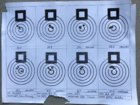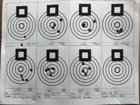mikeeg02
Michael Glantz
Resurrecting a good, relevant thread (I think).
I've been trying to get my new 6BRA tuned. Tried Federal GM205M and CCI BR-4 primers running H4895 ladders between 30.0 and 31.0 gr behind 105 Berger Hybrids seated at .010 jam. Lapua brass, fired 4x and induction annealed. Then I tried 450's "because everyone else is doing it". I didn't pierce (blank) any of the 450 primers but about half of them were extruded around the firing pin, some with as low as 30.2 gr. I didn't notice it right away because I had barely any other pressure signs.
If this was a basic factory action I'd assume it's the pin fit and have the bolt bushed. But this is a new action from a longtime custom action builder. Name withheld in case I should go to them for technical support.
So this suggests that out of those three, the 450's are the least tolerant of pressure by a large margin (0.8 grains). That just doesn't seem right. I have not tried 400's but clearly I should avoid them.
I'll admit I'm new to 6BR* game - so I'm looking for ideas of what to check and explore next.
What did your groups look like with 205s? Try going down and starting around 29 grains. Maybe even 28.5. Could be a fast lot of h4895. With the hunter bullet "a" and annealed cases I'm backed off to 29.6 with 205s and h4895. No pressure signs, and it's only going 2920 the one time my buddy chronographed it, but its winning when I can keep all ten on paper.
450s play very well with rl15, but I've found a better load .15 grains lighter than my 450s load switching to 205s. Less vertical at 1k.













